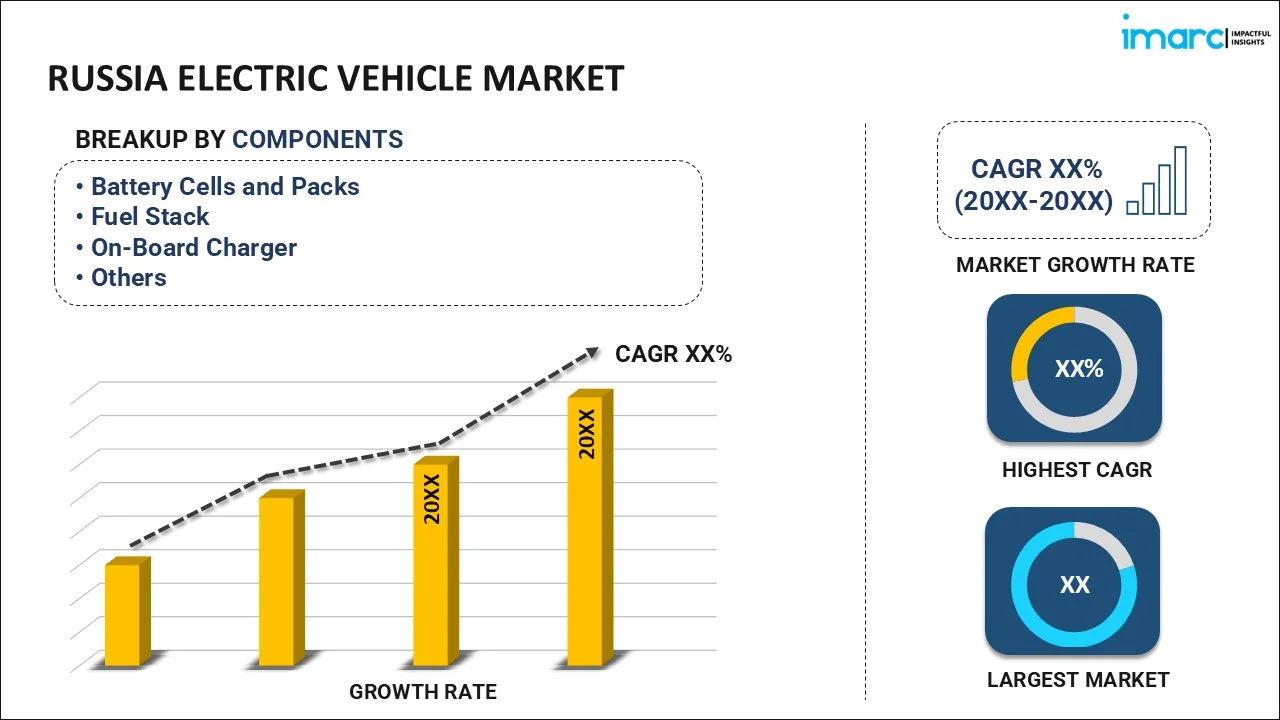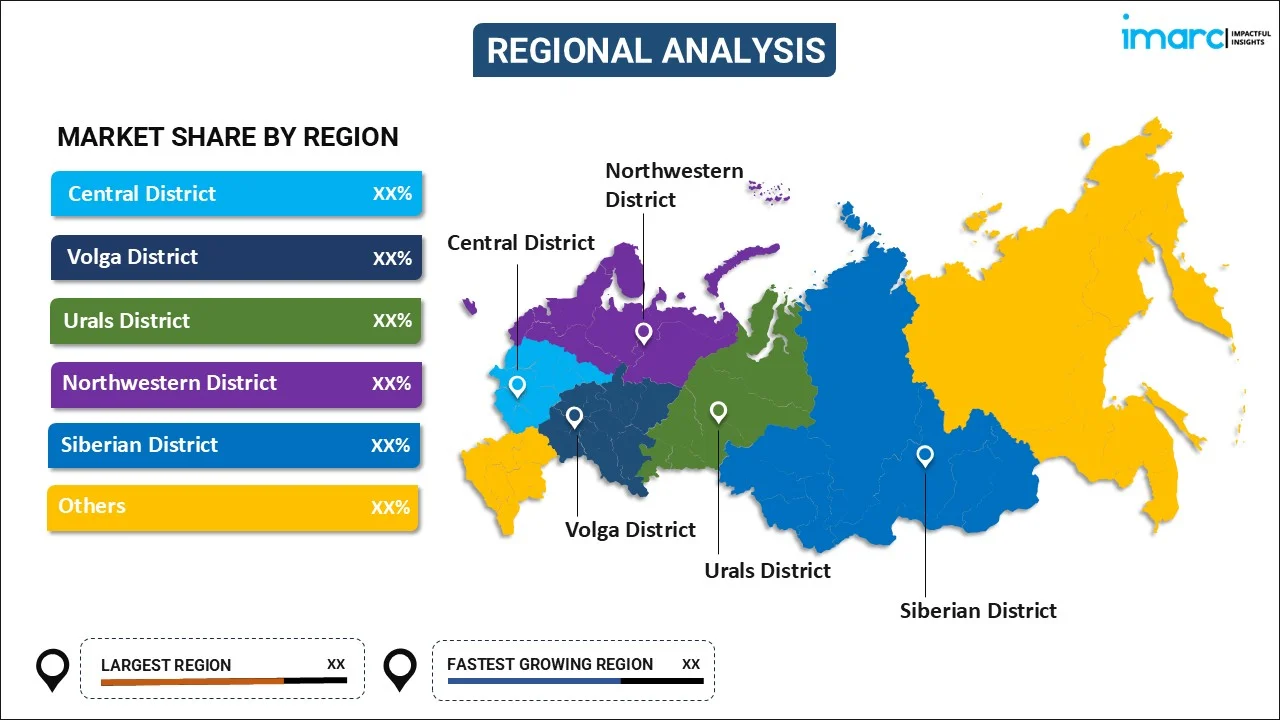
Russia Electric Vehicle Market Report by Component (Battery Cells and Packs, Fuel Stack, On-Board Charger, Electric Motor, Brake, Wheel and Suspension, Body and Chassis, and Others), Propulsion Type (Battery Electric Vehicle (BEV), Fuel Cell Electric Vehicle (FCEV), Plug-In Hybrid Electric Vehicle (PHEV)), Vehicle Type (Passenger Vehicles, Commercial Vehicles, and Others), and Region 2025-2033
Russia Electric Vehicle Market Overview:
The Russia electric vehicle market size reached 8.2 Thousand Units in 2024. Looking forward, IMARC Group expects the market to reach 145 Thousand Units by 2033, exhibiting a growth rate (CAGR) of 35.20% during 2025-2033. The market is primarily driven by increased government support and incentives accelerating EV adoption, a significant rise in domestic production fueled by local and international investments, continual advancements in charging infrastructure enhancing accessibility. Additionally, the implementation of stringent guidelines promoting EV adoption to align with sustainability goals is contributing to the growth of the Russia electric vehicle market share.
|
Report Attribute
|
Key Statistics
|
|---|---|
|
Base Year
|
2024
|
|
Forecast Years
|
2025-2033
|
|
Historical Years
|
2019-2024
|
| Market Size in 2024 | 8.2 Thousand Units |
| Market Forecast in 2033 | 145 Thousand Units |
| Market Growth Rate 2025-2033 | 35.20% |
Russia Electric Vehicle Market Trends:
Increase in Government Support and Incentives
The Russian market needs more government help and incentives significantly in order to hasten the uptake of electric vehicles across the country. Recently, the government has introduced certain policies, for instance, granting subsidies on purchases of electric cars, tax concessions, and reductions in import customs duties on electrical cars and spare parts. Substantial financing is being placed in building full-scale charging networks, enhancing ease of use, and access by individuals. Added support comes with initiatives aimed at raising public knowledge about the ecological and economic value of electric mobility. Such support strategy goes alongside global initiatives directed toward fighting climatic change in Russia, a move aimed to reduce its fuel dependence on fossils and help realize a greener innovative automotive industry. The Russia electric vehicle market forecast indicates continued growth, driven by these supportive policies and rising user demand.
Rise in Domestic Production
The market is witnessing a tremendous increase in domestic production mainly due to rising investments from local automotive companies. The major companies are focusing on developing and launching new electric models to meet the growing demand of consumers and to improve their competitive advantage in the global market. This trend is supported by strategic partnerships with international EV technology firms, which facilitate the transfer of advanced technologies and expertise. In addition to this, the government is promoting domestic production through positive policies and financial incentives. The growth in local manufacturing not only looks to reduce reliance on imported vehicles but also to grow a healthy EV ecosystem within Russia, furthering economic development and technological innovation. This growth in domestic production is expected to positively impact the Russia electric vehicle market share, reflecting a more competitive and self-sufficient industry.
Expansion of Charging Infrastructure
Charging infrastructure development would be a primary trend in this market, which really affects the wide adoption and applicability of electrical vehicles. Toward this demand, significant funds are being planned to develop charging stations in integrated networks across city and rural setups. Both the public and private sectors are actively participating in this venture. Fast-charging stations are placed at highways, commercial centers, and residential complexes. These expansion infrastructures are further enhanced through government incentives and regulatory support, promoting private investment and innovation in charging technologies. The increased accessibility to charging stations directly benefits the electric vehicle owners as well as pushes the overall acceptance of electric mobility for Russia's pursuit of environmental sustainability and economic diversification. This expansion of charging infrastructure is expected to significantly drive Russia electric vehicle market demand.
Russia Electric Vehicle Market News:
- December 2024: MG will launch the MG HS in the Russian market in early 2025, offering both fuel and plug-in hybrid electric vehicle (PHEV) versions with two power options: 1.5T and 2.0T engines. The car was unveiled at the 2024 Goodwood Festival of Speed and is designed as an improved version of China's Roewe RX5. The PHEV model will feature a 1.5T engine combined with an electric motor for enhanced performance and range.
- December 2024: The MG4 EV, a pure electric compact crossover, officially entered the Russian market with a selling price of 5,300,000 rubles. The car, launched in the all-wheel-drive XPower version, offers advanced features like a dual-motor system, 320 kW power, and a 0-100 km/h acceleration in 3.8 seconds. The MG4 EV is designed with a modern aesthetic and high-tech interior, including a 10.25-inch floating central control screen.
- October 2024: Belarusian company BKM Holding launched nine electric buses and three charging stations in Sochi, Russia. The new fleet, which began operations on October 1, includes BKM Holding's E321 electric buses, designed for urban transport with features like non-cash payment and climate control. This move supports Sochi's shift toward sustainable public transportation.
- August 2024: LUKOIL announced the launch of its specialized transmission fluid, LUKOIL E-FLUID 301, for electric vehicles. The fluid, designed for cars with direct motor-to-transmission contact, is already available at authorized service stations and will soon be sold in retail. This move highlights LUKOIL's capability in creating advanced products for the growing electric vehicle market.
- February 2024: Russia announced that the production of its E-Neva electric car, developed by the Almaz-Antey consortium, will begin in 2026. The car will be manufactured at the former Toyota plant, with ongoing development despite slow progress. The project is part of Russia's efforts to advance its electric vehicle industry.
- July 2024: Avtotor showcased its latest electric vehicles at the Energy Forum in Mineralnye Vody on 3rd July 2024, highlighting advancements in sustainable automotive technology. The presentation featured cutting-edge electric car models equipped with advanced battery technology and performance enhancements. This event emphasized Avtotor’s commitment to eco-friendly transportation and provided a platform for discussing industry trends and future developments in electric vehicles.
- October 2023: Lipetsk-based company Motorinvest reported that the company will bring 8 new Dongfeng models to the Russian market by the end of the first quarter of 2024. The brand will expand its lineup with mid-size crossovers, full-size premium crossovers, compact crossovers, full-size SUVs, coupe-crossovers, and large frame SUVs. The expansion will also include the increase of the official Dongfeng dealer network in Russia with up to 100 new authorized service, sales, and service points for Dongfeng passenger cars by the end of 2023.
Russia Electric Vehicle Market Segmentation:
IMARC Group provides an analysis of the key trends in each segment of the market, along with forecasts at the country level for 2025-2033. Our report has categorized the market based on component, propulsion type, and vehicle type.
Component Insights:

- Battery Cells and Packs
- Fuel Stack
- On-Board Charger
- Electric Motor
- Brake, Wheel and Suspension
- Body and Chassis
- Others
The report has provided a detailed breakup and analysis of the market based on the component. This includes battery cells and packs, fuel stack, on-board chargers, electric motor, brake, wheel and suspension, body and chassis, and others.
Propulsion Type Insights:
- Battery Electric Vehicle (BEV)
- Fuel Cell Electric Vehicle (FCEV)
- Plug-In Hybrid Electric Vehicle (PHEV)
A detailed breakup and analysis of the market based on the propulsion type have also been provided in the report. This includes battery electric vehicle (BEV), fuel cell electric vehicle (FCEV), and plug-in hybrid electric vehicle (PHEV).
Vehicle Type Insights:
- Passenger Vehicles
- Commercial Vehicles
- Others
The report has provided a detailed breakup and analysis of the market based on the vehicle type. This includes passenger vehicles, commercial vehicles, and others.
Regional Insights:

- Central District
- Volga District
- Urals District
- Northwestern District
- Siberian District
- Others
The report has also provided a comprehensive analysis of all the major regional markets, which include Central District, Volga District, Urals District, Northwestern District, Siberian District and Others.
Competitive Landscape:
The market research report has also provided a comprehensive analysis of the competitive landscape. Competitive analysis such as market structure, key player positioning, top winning strategies, competitive dashboard, and company evaluation quadrant has been covered in the report. Also, detailed profiles of all major companies have been provided.
Russia Electric Vehicle Market Report Coverage:
| Report Features | Details |
|---|---|
| Base Year of the Analysis | 2024 |
| Historical Period | 2019-2024 |
| Forecast Period | 2025-2033 |
| Units | Thousand Units |
| Scope of the Report | Exploration of Historical Trends and Market Outlook, Industry Catalysts and Challenges, Segment-Wise Historical and Future Market Assessment:
|
| Components Covered | Battery Cells and Packs, Fuel Stack, On-Board Charger, Electric Motor, Brake, Wheel and Suspension, Body and Chassis, Others |
| Propulsion Types Covered | Battery Electric Vehicle (BEV), Fuel Cell Electric Vehicle (FCEV), Plug-In Hybrid Electric Vehicle (PHEV) |
| Vehicle Types Covered | Passenger Vehicles, Commercial Vehicles, Others |
| Regions Covered | Central District, Volga District, Urals District, Northwestern District, Siberian District, Others |
| Customization Scope | 10% Free Customization |
| Post-Sale Analyst Support | 10-12 Weeks |
| Delivery Format | PDF and Excel through Email (We can also provide the editable version of the report in PPT/Word format on special request) |
Key Benefits for Stakeholders:
- IMARC’s industry report offers a comprehensive quantitative analysis of various market segments, historical and current market trends, market forecasts, and dynamics of the Russia electric vehicle market from 2019-2033.
- The research report provides the latest information on the market drivers, challenges, and opportunities in the Russia electric vehicle market.
- Porter's five forces analysis assist stakeholders in assessing the impact of new entrants, competitive rivalry, supplier power, buyer power, and the threat of substitution. It helps stakeholders to analyze the level of competition within the Russia electric vehicle industry and its attractiveness.
- Competitive landscape allows stakeholders to understand their competitive environment and provides an insight into the current positions of key players in the market.
Key Questions Answered in This Report
The Russia electric vehicle market was valued at 8.2 Thousand Units in 2024.
IMARC estimates the Russia electric vehicle market to exhibit a CAGR of 35.20% during 2025-2033, reaching a value of 145 Thousand Units by 2033.
The key factors driving the Russia electric vehicle market include government incentives for eco-friendly transportation, rising environmental awareness, and advancements in EV infrastructure. Additionally, growing concerns over air pollution, fuel efficiency, and international commitments to reduce carbon emissions are pushing people and businesses toward adopting electric vehicles.
Need more help?
- Speak to our experienced analysts for insights on the current market scenarios.
- Include additional segments and countries to customize the report as per your requirement.
- Gain an unparalleled competitive advantage in your domain by understanding how to utilize the report and positively impacting your operations and revenue.
- For further assistance, please connect with our analysts.
 Inquire Before Buying
Inquire Before Buying
 Speak to an Analyst
Speak to an Analyst
 Request Brochure
Request Brochure
 Request Customization
Request Customization




.webp)




.webp)












